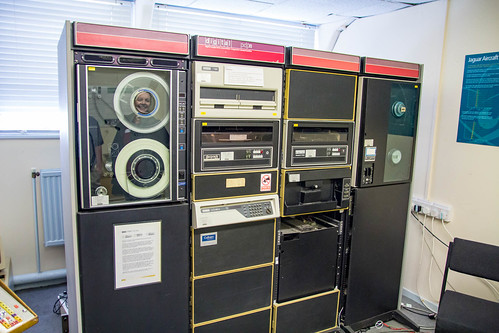Article co-written by Jeffrey Osier-Mixon and Dawn Foster
What do a few geeks do when they find themselves on the way to Dublin for LinuxCon Europe? They make a side trip to Bletchley Park, of course. Seeing the place where Alan Turing, father of computer science, broke the German Nazi Enigma codes in the second World War was quite an experience. In this article, Jeffrey Osier-Mixon (community manager at the Yocto Project at Intel) and I describe a few of the highlights of our geeky and wonderful side trip.
Bletchley Park was one of Britain’s best-kept secrets, and for decades after the war, the people who worked there were still sworn to secrecy. The work at Bletchley Park is believed to have saved thousands of lives and shortened the war by about two years, but it wasn’t until 2009 that the people working at Bletchley were publicly recognized for their service. For more about the history, read an in-depth story on the Bletchley Park website.
The Enigma machines that the German Nazis used to encode their communications were enormously complex and nearly impossible to break with 159 million million million possible settings on the machine and codes that changed every single day. Ultimately, our human tendency to be predictable by using the same language in common communications, such as weather reports, along with Alan Turing’s invention of a machine that could cycle through many possible codes very quickly made it possible to decode the Nazi communications. Although many of these machines, the bombes, were made, they were sadly destroyed after the war to protect the secrecy of the code-breaking work at Bletchley Park. The good news is that they have been able to recreate a working version of the bombe by reverse engineering it from old, classified documents.
Flickr photo album by Jeffrey Osier-Mixon
We started our tour of Bletchley Park by watching a demonstration of the recreated bombe showing how it was used to break the enigma codes. Nearby sections also have real Enigma machines from the war on display. The demonstration was thorough, explaining in detail the iterative process the machine followed, and laborious methods for "programming"—literally moving cables from one place to another inside the machine and changing settings on the spools. The only thing missing was a steam engine and magic wand.
Back outside and up the walkway, we came to Hut 8, one of the magnificently re-created working huts that provided offices and temporary homes for the 12,000 people who worked at Bletchley during the war. Like the other huts we visited, the rooms were set with fine attention to detail, as if the occupants had simply stepped out temporarily and would be back any moment. Some of the rooms had audio re-creations of period sounds—phones ringing, people talking in hushed voices—and some also had projections of actors displayed behind desks or sitting on chairs. It was two-dimensional, of course, but in a darkened room with appropriate sounds, the effect was charming and mesmerizing. Hut 8 was also home to the office of Alan Turing himself, and each of us lingered a little bit longer there imagining the conversations that must have happened in that very room.
We visited a few other huts and then walked over to the mansion, a huge, rambling set of brick buildings which was used during the war as offices for the military personnel who ran Bletchley Park, and which was also used recently as a set for the film The Imitation Game. As with the huts, many of the rooms were decorated with period furniture, and the piece de resistance was the bar in the back room with what looked like a small dance floor, and a re-created bombe in the corner.
After lunch on the lawn next to a pond with a pair of swans, we walked to The National Museum of Computing, where we were able to see other historical computing machines in action, including Colossus and Tunny, both also used during World War II to break encrypted messages from the Nazis, as well as the Harwell Dekatron, or WITCH, a computer based on digital relays built in the 1950s, now known as "the oldest original functioning electronic stored program computer in the world". Each of these machines has volunteers who spend many hours making them work again, finding parts in odd corners of the world. One of these volunteers was our guide, Dave Anders, who has found many of the dekatron relays—or valves—and dedicates time every year to the preservation and continued operation of these icons of computing history.
The Museum continues on for room after room, each with a collection of computing devices from various periods in history. We found ourselves trying to name each item. Is that a PDP-10 or a PDP-11? Is that really an air traffic control radar screen? I had that calculator as a kid! But what was most fascinating was that everything in the entire museum was in working order, even the giant washing-machine-like disk drives and 9-track tape drives straight out of James Bond, even the Cray supercomputer and the Friden 130 electronic calculator—the first solid state calculator—and even the ancient video games and the Burroughs adding machines from ye olden days. Everything worked.
So if you are geekily inclined and ever find yourself in the English Midlands near Milton Keynes, the pilgrimage to Bletchley Park and the National Museum of Computing should be top on your list. And if you happen to work in an industry that owes some homage to these historical machines, make a point to find out whether your company can make a donation to keep this history alive.





4 Comments